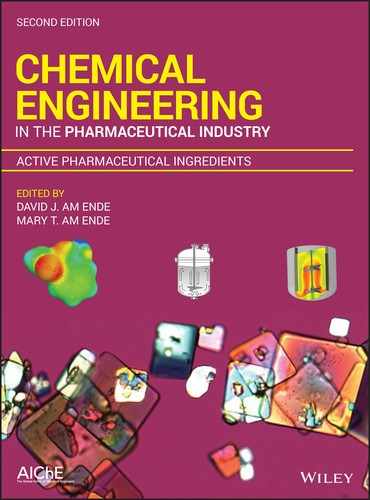PREFACE
Chemical Engineering in the Pharmaceutical Industry is unique in many ways as to what is traditionally taught in schools of chemical engineering. This book is thus intended to cover many concepts and applications of chemical engineering science that are particularly important to the pharmaceutical industry. Several excellent books have been written on the subjects of Process Chemistry in the Pharmaceutical Industry and separately on formulation development, but relatively little has been published specifically with a chemical engineering focus.
The intent of this book is to highlight the importance and value of chemical engineering to the development and commercialization of pharmaceuticals covering active pharmaceutical ingredients (APIs) and drug products (DPs). It should serve as a resource handbook to practicing chemical engineers as well as a resource for chemists, analysts, technologists, and operations and management team members – all those who partner to bring pharmaceuticals successfully to market. The latter will benefit through an exposure to the mathematical and predictive approach and the broader capabilities of chemical engineers as well as to illustrate chemical engineering science specifically to pharmaceutical problems. This book emphasizes the need for scientific integration of chemical engineers with synthetic organic chemists within process R&D, as well as the importance of the interface between R&D engineers and manufacturing engineers.
Although specific workflows for engineers in R&D depend on each company's specific organization, in general it is clear that, as part of a multidisciplinary team in R&D, chemical engineering practitioners offer value in many ways including API and DP process design, scale‐up assessment from lab to plant, process modeling, process understanding, and general process development that ultimately reduces cost and ensures safe, robust, and environmentally friendly processes are transferred to manufacturing. How effective the teams leverage each of the various skill sets (i.e. via resource allocation) to arrive at an optimal process depends in part on the roles and responsibilities as determined within each organization and company. In general it is clear that with increased cost pressures facing the pharmaceutical industry, including R&D and manufacturing, opportunities to leverage the field of chemical engineering science continue to increase. The increased emphasis and broader implementation of continuous processing from R&D to manufacturing over the last 10 years is a good example.
In the first edition of this book, 44 chapters spanned API, drug product, and analytical. The second edition has expanded to 75 total chapters, and for this reason we divided the book into two discrete volumes to separately focus on API and drug product.
The second edition of this book is divided into following sections:
Volume 1: API/Drug Substance
- Introduction
- Mass and Energy Balances
- Reaction Kinetics and Mixing Processes
- Continuous Processing
- Biologics
- Thermodynamics
- Crystallization and Final Form
- Separations, Filtration, Drying, and Milling
- Statistical Models, PAT, and Process Modeling Applications
- Manufacturing
- Quality by Design and Regulatory
Volume 2: Drug Product
- Introduction
- Drug Product Design, Development, and Modeling
- Continuous Manufacturing
- Applied Statistics and Regulatory Environment
The second edition has many new chapters and significantly expanded previous chapters. We have 13 chapters devoted to applied thermodynamics, final form, and crystallization. Eight new chapters are case studies. New chapters were added on continuous processing and quality by design as well.
The contributors to these two volumes were encouraged to provide worked‐out examples – so in most chapters a quantitative example is offered to illustrate key concepts, assumptions, and a problem solving approach. In this way, the chapters serve to help others solve similar problems.
There are many people to thank that made the original book project possible.
It was during my time at Pfizer from 1994 to 2013 in Chemical R&D where I began to truly appreciate my career choice and how chemical engineering science could add value to pharmaceutical projects and project teams. I was fortunate to get my start at Pfizer working with the Mettler RC1 and FTIR and having the opportunity to build the process safety, reaction engineering, and later engineering technologies group within Chemical R&D. It was there that I was inspired to take on this project for the first edition of this book. I am grateful to my Chemical R&D management for permitting me to fulfill that vision in 2010. In 2013, I partnered with Jerry Salan and joined Nalas Engineering.
Special thanks to my family (Mary, Nathan, Noah, Brianna) for their support during the preparation of this book. Special thanks to Mary, not only for contributing multiple chapters in this book but also for assisting in all phases of the project and as coeditor for the second edition. In addition, a special thanks to my parents for their encouragement to pursue chemical engineering in 1983 and their support ever since.
